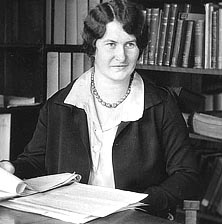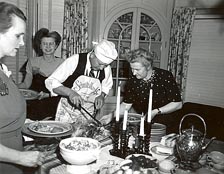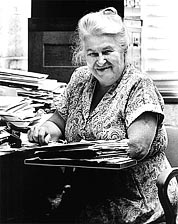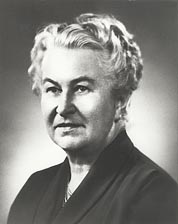
Early Life and Education
Helen Hart (Fig. 1) was born on September 2, 1900 in Janesville, Wisconsin to Richard Johnson Hart, a dentist from York, England, and Alice Hart (nee Echlin) of Janesville (17). Little is known about Helen Hart’s early life. A colleague would later report, perhaps entirely facetiously, that "she was conditioned to men at an early age by membership in a neighborhood gang of boys in her home town," and that this prepared her for life as a scientist (3). In any case, she attended Janesville’s public schools, where she enjoyed her science classes above all others, and graduated from high school in 1918 (8,13). She left Janesville the following fall for Lawrence College, a coed liberal arts college in Appleton, and transferred in 1920 to the University of Minnesota where she would remain for essentially all of her professional career. She received a BA in botany in the spring of 1922.
| |

Fig. 1. Helen Hart in 1936. Photo courtesy University of Minnesota's Department of Plant Pathology. |
|
Near the end of her undergraduate work, Hart told her botany professors of her interest in continuing her study of plants. She was referred to the University Farm and the Department of Plant Pathology, chaired by Elvin C. Stakman. Stakman, whose strong involvement in the Department’s affairs was then customary among department heads (10), urged Hart to seek another profession. Professor Julian G. Leach initially agreed, conceding that women plant pathologists would only find themselves under-compensated and under-recognized. But in the summer of 1922, Hart visited the University Farm again, this time (perhaps coincidentally) while Stakman was away in Australia (17). This time, Leach relented and admitted Hart to the graduate school as a Laboratory Assistant. Stakman would later recall, "I came back and said I thought you were going to be cautious about encouraging women. Well, he said he didn't encourage them, but he said she isn’t just a woman, she's an extraordinary one. And well, it turned out that that was so" (14).
As a Laboratory Assistant, Hart began work on her master’s degree while assisting with field experiments and performing chores in the lab. Majoring in plant pathology and minoring in plant physiology, Hart excelled in her studies. In 1923, Hart began a decade-long appointment as Agent in the Office of Cereal Crops and Diseases of the USDA’s Bureau of Plant Industry (11,18).
Women and Science: Some Historical Context
The two decades before Helen Hart began her career had been turbulent years for women who wished to become scientists. Public awareness, educational opportunities, and low-level employment had all increased, improving the lives of women in the sciences. In part, these changes had resulted from WWI, but they were also the results of a deliberate strategy of confrontation and reform, related in some ways to the Suffrage Movement. However, by about 1920 it had become clear that a backlash against women in science was developing in some circles, and that women would still commonly need to work harder than men and earn more degrees, even to attain comparatively meager advancements. Unemployment remained very high among women scientists, especially if married (15).
During the 1920s and 1930s, a new generation of women scientists in America took a less direct, less confrontational approach. Historian Margaret Rossiter calls it a "strategy of overqualification and personal stoicism" (15). Focusing on excellence, dedication, loyalty, and silence, "in time such women became the extraordinarily well-qualified, uncomplaining, and utterly self-sacrificing paragons that abound in the obituaries of women scientists" (15). In this way, Helen Hart’s generation of women scientists achieved many of the advancements for which the previous generation fought and prepared the way, but could not achieve themselves.
Paradoxically, Helen Hart was representative of her generation of women scientists precisely because she was exceptional. Due to her unrelenting dedication to the study, profession, and institutions of plant pathology, and due to the great benevolence and generosity of her manner, she reached heights in her profession unattained by women before her, and her sacrifices opened doors to women plant pathologists who followed. As her mentor and friend Elvin C. Stakman noted -- in a description that captures only part of her story -- Hart "helped break down the prejudicial treatment afforded women in science because she was not a troublemaker" (14).
Research
The research of nearly all graduate students in the Department was assigned and officially directed by Stakman (10), and thus the Department’s focus was decidedly on variation in the fungi that cause plant diseases. According to C. M. Christensen, "Stakman thought, talked, wrote, lectured, preached, and propagandized on [the nature, cause, and extent of variation in fungi] endlessly"(10). Hart began her own research career with studies of flax rust.
Hart’s master’s thesis, "Factors Affecting the Development of Melampsora lini (Pers.) Desm.," was presented in 1924 (12). The thesis documents a close investigation into the role of environmental conditions in the life-cycle of the fungus that causes flax rust and the progress of infection. The last chapter of the thesis begins Hart’s lifelong investigation into the physiologic races of fungi and the problem of using pathogen specialization to develop resistant cultivars (12). Once awarded her master’s degree, Hart became a part-time Instructor in the Department of Plant Pathology; by this time Stakman had undoubtedly changed his mind about encouraging Helen Hart (Fig. 2).
| |

Fig. 2. Helen Hart in 1947 helping Elvin Stakman with Christmas dinner at his home. Mrs. J. J. Christensen and Mrs. Don Fletcher are at left. Photo from E. C. Stakman, Statesman of Science (10). |
|
Hart began work on her Ph.D. research and four years later, in 1929, defended her doctoral thesis, "Morphological and Physiological Studies on Stem Rust Resistance in Wheat" (13). Hart’s thesis research was on the structure of wheat plant tissues and its relation to the morphology of the stem rust pathogen. At the time of her research, the role of host and pathogen morphology was generally being de-emphasized in favor of physiological factors, and thus Hart’s inclusion of functional resistance in her rigorous investigations of host-pathogen relationships constituted a renewed, sophisticated assertion of the importance of morphology in phytopathology.
Thus began a research and publishing career that played an important role in making the University of Minnesota’s Plant Pathology Department a world-leader in research on stem rust of cereals (11). The large majority of Hart’s publications reported research into the biology and physiologic races of stem rust and/or questions of resistance to stem rust or environmental conditions in the disease’s development. Hart’s work and that of her advisees represent an important and enduring contribution to the study of stem rust of wheat and the challenge of understanding and exploiting pathogen specialization and cultivar resistance.
Forward-thinking and highly cooperative in her research style, Hart and her students were pioneers in the use of controlled environments to study environmental factors in the interactions of pathogen and host. Their studies explored the varying races of stem rust, the modes and variations of its infection of different wheats, and the potential for chemical control of rust diseases. In addition to these glasshouse experiments and valuable work in the laboratory, Hart’s research programs involved important field studies. To evaluate wheat germ plasm for resistance to stem rust, she worked in cooperation with breeders from the USDA’s International Stem Rust Nursery program, the University of Minnesota’s Department of Agronomy and Plant Genetics, and her own colleagues in the Plant Pathology Department. She also participated in coordinated programs to trace annual outbreaks of wheat stem rust, of particular importance during the devastating outbreaks of wheat stem rust across the Great Plains in 1954 (10,18). These studies were instrumental in the development of Minnesota’s stem rust resistant wheat varieties, and in deepening the understanding of all aspects of wheat stem rust. Among other honors Hart received for her research was the Elvin C. Stakman award for outstanding contributions to knowledge of cereal diseases in 1963, and she eventually became a Fellow of the American Association for the Advancement of Science (11).
Life in the Department
Hart became a full-time Instructor in the Department of Plant Pathology in 1933, a full Professor in 1947, and retired as Professor Emeritus in 1966. She rarely taught classes, and until the mid-1940s, Stakman officially served as principal advisor to all graduate students (10). After 1945 however, Hart frequently acted as advisor to students, and her advisees were disproportionately students from foreign countries. She frequently served as a mentor to students well beyond the call of her academic duties; she often helped students who attended the annual American Phytopathology Society (APS) meeting by providing them with money enough for meals (18). Stakman reports that Hart’s influence, guidance, and assistance were important to every female graduate student in the department and virtually every male (14).
Aside from her work as advisor to student researchers, Hart’s greatest contribution to the Department’s educational environment may have been as a reader, editor, and chair of the Language Committee. Her writing abilities were noticed at least as early as the writing of her master’s thesis, and once Hart became a member of the faculty, her skills were put to good use. Almost all theses on stem wheat rust that were written in the Department of Plant Pathology at the University of Minnesota during Hart’s career thank her for her attention to the research conducted and for her help in writing the manuscript (18). Stakman noted that Hart assisted with the preparation of his own students’ theses; "I did my share of editorial work, but there were many delays and Miss Hart was beautiful at editorial work" (14). As the chair of the department’s Editorial Committee from approximately 1929 to 1954, all manuscripts produced by members of the Department were either edited by Hart or assigned by her to another faculty member (18).
Otherwise remembered as unimposing and generous, Hart appears to have been uncompromising in her pursuit of linguistic excellence. She supervised the Department’s dreaded reading examination, which every plant pathology graduate student at the University of Minnesota had to pass. The Department’s 1956 Christmas party featured skits parodying the students’ various trials and tormentors, including "a bout with Miss ‘Hartless’ (HH) in attempting the language hurdle. New students were dismayed and veterans amazed at the accuracy of the portrayals" (5). Hart had a hand in the design of the Department’s seminar class and she advised its students as they wrote abstracts and prepared for presentations. Hart seized this opportunity to advance the student’s composition skills, editing every draft of each abstract and summary, often through four or five drafts. Nevertheless, speaking during the seminar itself was something Hart almost never did (18).
Fluent in German, with a working knowledge of French and Spanish, Hart was invaluable in students’ passage of the Graduate School’s foreign language requirements. Hart either examined each student in advance of the Graduate School’s mandated exams, or had another faculty member fluent in the language in question test the student’s readiness and report back to Hart. Rehearsals for the language exams were repeated until Hart was satisfied that the student was prepared (18).
Ironically, Hart seems to have been complimented most often for her exceptional language skills and for her reluctance to speak. In a skit celebrating her 1954 election as APS President, a colleague’s jokes, while sexist, also suggest how intimately Hart was associated with her quietude:
In addition, she has that most rare and precious trait in woman—the gift of silence. Never known to be long-winded, verbose, or voluble, her friends say that she gives forth speech in public with as much pain as a Scot gives out his money. Risen to the present position of eminence among plant pathologists without benefit of self-advertisement, she is that unique woman who sees all, listens to all, and tells nothing (3).
Aside from her teaching and research, Hart’s contribution to the functioning of the Department was both essential and largely unseen. Hart and J. J. Christensen served as sounding boards for Stakman’s scientific, educational, and policy ideas, and were often left to implement the results during Stakman’s frequent absences from the department. Some believe Hart’s good common sense and her ability to evaluate individual character were valuable and needed supplements to Stakman’s own abilities in these areas (18).
Fully dedicated to the Department of Plant Pathology at the University of Minnesota, Helen Hart was in no small way one of its guiding spirits. She extended a very heartfelt hand of friendship to the children and spouses of new faculty, thus easing their transition into their lives at the University of Minnesota. For two decades, Hart served as the editor and publisher of the Department’s newsletter, the Aurora Sporealis, a significant force in creating a sense of community for the department. Early in her tenure at Aurora, someone – maybe Hart herself – lists her as "charwoman" of its publication committee (1). The modest and often irreverent publication provided alumni and current students with news about nearly everything in the life of the Department. In its pages, Hart is described as an avid cheerleader and propagandist for the Department’s "kittenball" team (a softball variant taken a bit seriously at the University from the 1930s through the 1950s), and as a member of the Department’s apparently formidable women’s bowling team (18).
Details about Hart’s life beyond the Department are largely unknown, and it is possible that such a life hardly existed. She rarely traveled except for her work with the American Phytopathological Society and occasional vacations to Northern Minnesota, Canada, or her home town of Janesville (18). She visited Europe three times, including her year as Exchange Assistant at Germany’s Institute für Pflanzenbau und Planzenzüchtung, Universität HalleSaale, 1937-1938 (6,11). The Aurora reports in 1944 that Hart and Stakman’s assistant "spent a week’s vacation at Wheaton, Illinois (near Chicago) early in June. Highlights of the trip were a half day’s visit to the Morton Arboretum at Lisle, Illinois, mowing lawns, weeding, and teaching a litter of six young pups to drink from a saucer" (2). According to a 1963 newspaper article (Fig. 3), "Explaining that she does not join many outside activities or attend luncheons, Dr. Hart said, ‘You just about have to live with those plants’ " (7). The reporter repeatedly describes Hart’s puzzlement when asked about her spare-time hobbies. When another journalist asked how a plant doctor’s garden grows, Hart denied having a garden at her home two blocks from the University Farm: "I have a lot of indoor plants, mostly African violets … They’re all healthy" (6).
| |
 |
|
| |
Fig. 3. "Plant Scientist Works 70-Hour Week." Helen Hart as she appeared in a July 1963 article for the Women’s Section of the Minneapolis Tribune. Photo by Gerald Brimacombe. © Star Tribune/Minneapolis-St. Paul. |
|
Hart and the American Phytopathological Society
Hart became a member of APS during her first months as a graduate student and maintained her membership until her death more than 48 years later. She took membership very seriously as both an honor and a professional duty and she regularly attended the Society’s national and regional meetings (18). She also regarded participation in the affairs of APS to be part of the proper education of new plant pathologists; while driving to the North Central Division meetings, her car was frequently packed with students.
In her first major contribution to the operation of APS, Hart used her abilities as a scientific writer in her role as an Associate Editor for Phytopathology from 1938 to 1940. In 1944, she became the first woman Editor-in-Chief of Phytopathology, a position she held until 1951, seeing the journal through the challenges of WWII and the transition years that followed. She served as a member of Council from 1944 to 1951, a duty that helped prepare her for her role as President.
Hart became President-Elect of APS in 1954 (Fig. 4), and the first woman President of the Society in 1955. By the mid-1950s, it was no longer uncommon for women to serve at the highest levels of governance in major American scientific associations, and by then many dozens of women had held the office of President of these organizations. But despite the exceptionally important contributions made by women to plant pathology compared to other sciences, APS had lagged in its election of its first woman President (16). Margaret Rossiter suggests that even Hart’s election may have been due in part to Stakman’s intervention, but Hart’s involvement with the organization makes clear that, in any case, she had certainly earned the honor and that the members of APS had elected a highly-qualified candidate for the job. To place her editorship and presidency in perspective within APS, it was over 30 years before women again occupied these positions; the second woman President of APS, Anne K. Vidaver, took office in 1987 and the second woman to serve as Editor-in-Chief of Phytopathology, Margaret E. Daub, appeared on the journal’s masthead in 1997.
| |

Fig. 4. Helen Hart around the time she became President of the American Phytopathological Society in 1955. |
|
Both R. D. Wilcoxson and the Aurora comment on the great pride felt in her Department over her election as President of APS (3,18). In its October-December 1955 issue, the Aurora reports:
No one could have been present in the Georgian Ball Room of the Atlanta Biltmore Hotel, Atlanta, Georgia, December 29, and not have been impressed by the appropriateness of the event which transpired. Minnesota’s own Dr. Helen Hart was installed as President of the American Phytopathological Society. Miss Hart, always a faithful worker for the Society, and distinguished Editor-in-Chief of its journal for eight years, received the Society’s highest honor and assumed its greatest responsibility. If Miss Hart needed further distinction, the fact that she became the first woman President of the Society added tribute to the quiet and unassuming manner with which her many contributions have been made (4).
As President, Hart strongly supported the Society’s work in developing the American Institute of Biological Sciences. She also helped to plan the Society’s 50th anniversary program and was a member of the editorial committee for the book marking the occasion, Plant Pathology, Problems and Progress, 1908-1958. The APS Secretary at the time of Hart’s term remembers her style when presiding over meetings as quiet, unassuming, and dignified, and remembers her as "always prepared and effective without aggression" (18). Hart was elected a Fellow of the American Phytopathological Society in 1965 (11).
Hart retired from her Department as Professor Emeritus in 1966. She moved in 1970 to Grants Pass, Oregon, where she died on May 2, 1971. Her obituary in the October 1971 issue of Phytopathology states that she was survived by a sister, Mrs. H. G. Deming of Grants Pass (11).
Acknowledgments
This article owes much to Roy Wilcoxson’s previous research and writing on the life of Helen Hart. I’m grateful for the generous assistance of Laura Morales of the Plant Pathology Library of the University of Minnesota. Many sincere thanks to Jean Ristaino and writer Jennifer Lynne Willoughby for their advice and encouragement.
Additional Resources
APSnet Features on Pioneering Women in Plant Pathology
Margaret Newton: Pioneering Cereal Rust Researcher
Effie A. Southworth: First Woman Plant Pathologist Hired at USDA
Flora W. Patterson: The First Woman Mycologist at the USDA
from APS Press:
Books on the history of plant pathology
from the National Women’s History Project:
Links about women in science
History of Science Society
from the National Academies:
Committee on Women in Science and Engineering
APS Joint Committee of Women in Plant Path & Cultural Diversity Committee
University of Minnesota:
History of Hart's Department of Plant Pathology
Kurt Gegenhuber's blog with "think pieces" on music, science, and history:
The Celestial Monochord
Literature Cited
1. Anonymous. 1929. Title page. Aurora Sporealis 5(2).
2. Anonymous. 1944. Untitled. Aurora Sporealis 20(3):8.
3. Anonymous. 1954. Kudos at Estes Park. Aurora Sporealis 30(3):6-7.
4. Anonymous. 1955. Miss Hart, President. Aurora Sporealis 31(4):1.
5. Anonymous. 1955. Christmas party. Aurora Sporealis 32(4):6.
6. Anonymous. 1961. Dr. Hart fights black rust: Sick wheat has been her lifetime patient. St. Paul Dispatch, November 1.
7. Anonymous. 1963. Plant scientist works 70-hour week: She won crop research award. Page 10W in: Minneapolis Sunday Tribune, July 14.
8. Brainard, V. 1950. Ladies, labs, and love. Page 1W in: Minneapolis Sunday Tribune, September 24.
9. Cartwrig, C. L., Shaffer, S., and Waller, R. 1998. City on the Rock River: Chapters in Janesville’s History. Janesville Historic Commission, Janesville, WI.
10. Christensen, C. M. 1984. E. C. Stakman, Statesman of Science. American Phytopathological Society, St. Paul, MN.
11. Eide, C. J. 1971. Helen Hart, 1900-1971. Phytopathology 61:1151.
12. Hart, H. 1924. Factors Affecting the Development of Melampsora lini (Pers.) Desm. M.S. thesis. Dept. Plant. Pathol., University of Minnesota, St. Paul, MN.
13. Hart, H. 1929. Morphological and Physiological Studies on Stem Rust Resistance in Wheat. Ph.D. thesis. Dept. Plant. Pathol., University of Minnesota, St. Paul, MN.
14. Knaphus, G. 1976. Conversation with E. C. Stakman. On file at the Plant Pathology Library, University of Minnesota, St. Paul, MN.
15. Rossiter, M. W. 1982. Women Scientists in America: Struggles and Strategies to 1940. Johns Hopkins Univ. Press, Baltimore, MD.
16. Rossiter, M. W. 1995. Women Scientists in America: Before Affirmative Action, 1940-1972. Johns Hopkins U. Press, Baltimore, MD.
17. Wilcoxson, R. D. 1996. Biography of Helen Hart. On file at the Plant Pathology Library, University of Minnesota, St. Paul, MN.
18. Wilcoxson, R. D. 1996. Helen Hart, remarkable plant pathologist (1900-1971). Annual Rev. Phytopath. 34:13-23.
